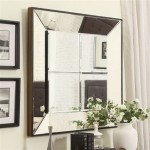Can I Spray Paint a Plastic Mirror Frame? A Comprehensive Guide
The question of whether a plastic mirror frame can be spray painted is a common one, particularly for individuals seeking to update their home décor on a budget. The answer, in short, is yes, it is generally possible to spray paint a plastic mirror frame. However, successful execution requires careful planning, appropriate preparation, and the selection of suitable materials. A poorly executed paint job can result in peeling, chipping, or an uneven finish, negating the desired aesthetic improvement.
Plastic, as a material, presents certain challenges when it comes to painting. Its smooth, non-porous surface offers poor adhesion for most paints. Furthermore, some types of plastic can react negatively with certain solvents found in paints, leading to softening, warping, or even melting. Therefore, understanding the type of plastic comprising the mirror frame and choosing the right paint are crucial steps in achieving a professional and durable finish.
Identifying the Type of Plastic
Before commencing the painting process, it is essential to identify the type of plastic used in the mirror frame. Identifying the plastic is not always straightforward, but certain characteristics can provide clues. Some plastic items have a recycling symbol molded into them, typically on the back or underside. This symbol often includes a number within a triangle, which corresponds to a specific type of plastic resin. Common plastics used for mirror frames include:
Polypropylene (PP): Characterized by its resistance to chemical solvents and high melting point. It is often used in items that need to be durable and heat-resistant. Polypropylene is generally difficult to paint due to its inherent resistance to bonding.
Polystyrene (PS): A rigid and often brittle plastic, polystyrene is commonly used for decorative items and packaging. It is relatively easy to paint, but it can be susceptible to chipping and cracking.
Acrylonitrile Butadiene Styrene (ABS): Known for its strength and impact resistance, ABS is frequently used for electronic housings and automotive parts. It offers good adhesion for paint and can withstand moderate wear and tear.
Polyvinyl Chloride (PVC): A versatile plastic used in a wide range of applications, including pipes, siding, and window frames. PVC can be painted, but it requires a specialized primer to ensure proper adhesion.
If the specific type of plastic cannot be identified, a cautious approach is recommended. This involves testing the chosen paint and primer on an inconspicuous area of the frame to assess its compatibility and adhesion before proceeding with the entire project. This "spot test" is a crucial step in preventing irreversible damage to the mirror frame.
Preparing the Plastic Surface
Proper surface preparation is paramount for achieving a successful and long-lasting paint job on plastic. This involves cleaning, sanding, and priming the frame to create a suitable surface for the paint to adhere to. Neglecting these steps will likely result in paint that peels, chips, or scratches easily.
The first step is to thoroughly clean the mirror frame to remove any dirt, grease, or grime. This can be accomplished using a mild dish soap and warm water. A soft cloth or sponge should be used to gently scrub the surface, paying particular attention to any areas with stubborn stains or residue. After cleaning, the frame should be rinsed thoroughly with clean water and allowed to dry completely.
Once the frame is dry, it is time to sand the surface. Sanding creates microscopic scratches on the plastic, providing a "key" for the primer to grip onto. A fine-grit sandpaper, typically between 220 and 320 grit, is recommended. The goal is not to remove material, but rather to create a slightly roughened surface. The frame should be sanded lightly and evenly, avoiding excessive pressure that could damage the plastic. After sanding, the frame should be wiped down with a tack cloth to remove any sanding dust.
Following sanding, a plastic primer is essential. Primer acts as an intermediary layer between the plastic surface and the paint, improving adhesion and preventing the paint from peeling or chipping. Choose a primer specifically designed for use on plastic. Apply the primer in thin, even coats, following the manufacturer's instructions. Allow the primer to dry completely before proceeding to the next step.
Selecting the Right Paint and Applying it Properly
The choice of paint is just as important as the preparation. Not all paints are created equal, and using the wrong type of paint can lead to disappointing results. When painting a plastic mirror frame, it is generally recommended to use an acrylic-based spray paint specifically formulated for use on plastic. These paints are typically more flexible than traditional paints, allowing them to expand and contract with the plastic without cracking or peeling. Avoid using solvent-based paints, as they can react negatively with some types of plastic.
Before painting, ensure the surrounding area is adequately protected. Cover any surfaces that you do not want to be painted with drop cloths or plastic sheeting. Work in a well-ventilated area to minimize exposure to paint fumes. Shake the spray paint can vigorously for at least two minutes to ensure that the paint is properly mixed.
Apply the paint in thin, even coats, holding the spray can about 10-12 inches away from the frame. Overlapping each pass slightly to ensure complete coverage. Avoid applying too much paint in a single coat, as this can lead to runs and drips. It is always better to apply multiple thin coats than one thick coat.
Allow each coat of paint to dry completely before applying the next. The drying time will vary depending on the type of paint and the environmental conditions. Consult the paint manufacturer's instructions for specific drying times. Once the final coat of paint has dried, consider applying a clear coat sealant to protect the paint and enhance its durability. A clear coat will also provide a more consistent sheen and improve the overall appearance of the finished product.
If any runs or drips occur, allow the paint to dry completely and then sand them smooth with fine-grit sandpaper before applying another coat of paint. Be patient and take your time to ensure a smooth and even finish. Remember, proper preparation and careful application are key to achieving a professional-looking result.
In addition to acrylic-based spray paints, specialty paints designed specifically for plastic surfaces are available on the market. These paints often contain additives that improve adhesion and durability. They may also offer enhanced resistance to scratches and fading. While these specialty paints tend to be more expensive than standard acrylic spray paints, they can provide superior results, especially for projects where durability is a major concern.
Furthermore, consider the desired finish when selecting a paint. Spray paints are available in a variety of finishes, including matte, satin, gloss, and metallic. The choice of finish will depend on the desired aesthetic. A matte finish provides a subtle, non-reflective look, while a gloss finish creates a shiny, reflective surface. A satin finish offers a balance between matte and gloss. Metallic finishes can add a touch of glamour and sophistication to the mirror frame.
Ultimately, the success of painting a plastic mirror frame hinges on thorough preparation, careful selection of materials, and patient application techniques. By following these guidelines, individuals can transform a dated or worn-out mirror frame into a stylish and eye-catching accent piece.

How To Paint Plastic Mirror Decorative Inspirations

Spray Painted Gold Yard Mirror How To Paint A Frame

How To Paint Plastic Mirror Decorative Inspirations

Spray Paint A Mirror Frame

Spray Painted Rainbow Mirror Makeover Colorshot Paint

How To Spray Paint A Mirror Step By Guide

Gold Plastic Oval Mirror Makeover Confessions Of A Serial Do It Yourselfer

How To Paint A Mirror Frame

How To Paint A Plastic Mirror Frame Look Like Wood Exquisitely Unremarkable

Spray Painted Gold Yard Mirror How To Paint A Frame








